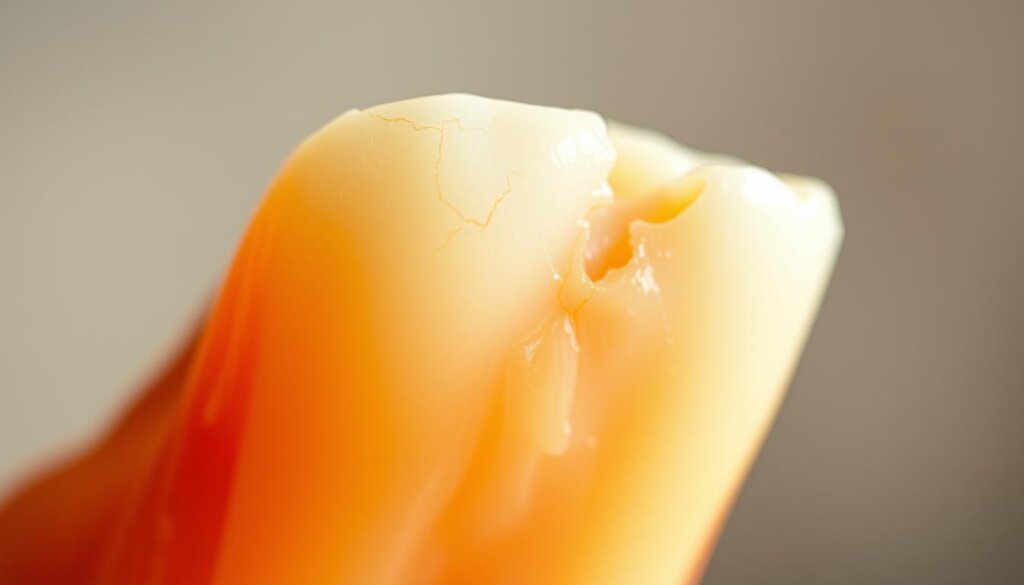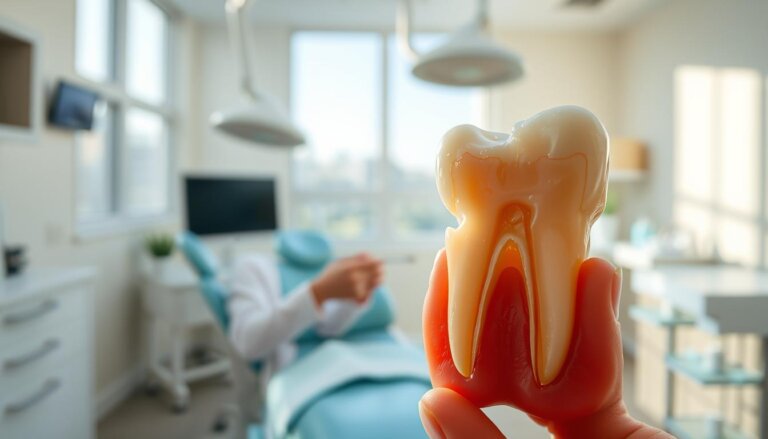Options to Fix a Broken Tooth: Bonding, Crown
Every year, five million teeth are lost in the United States. This raises important questions about keeping our teeth healthy for a long time. If a tooth breaks, many wonder, “What are the options to fix a broken tooth?”
Dental experts stress the importance of acting fast. This can prevent serious problems like infections or a misaligned bite.
There are many ways to fix a broken tooth. Some are quick and just for looks, while others are more complex to protect and strengthen the tooth. A dentist can look at the damage and suggest bonding or a crown. The choice depends on how deep the break is, where the tooth is, and what you prefer.
Each case is carefully looked at to make sure the tooth works well, feels good, and looks right. Often, bonding materials that match the tooth’s color can fix small chips. For bigger problems, crowns provide strong support.
Key Takeaways
- A cracked or broken tooth demands attention without delay.
- Bonding offers a quick route to minor chip repairs.
- Crowns deliver enhanced support for deeper structural issues.
- Evaluations by a dentist help pinpoint the best restoration method.
- Proper care after treatment preserves long-term dental health.
Understanding Broken Teeth
Cracked or chipped enamel often comes from biting hard objects or accidents. Grinding and aging also play a part. Enamel may seem strong, but it can break and reveal sensitive parts inside the tooth. The American Dental Association says finding damage early is key.
Early detection leads to quick fixes, saving the tooth. This helps keep the tooth healthy.
Common Causes of Tooth Damage
Typical reasons include:
- Excessive biting pressure on solid foods or objects
- Unanticipated accidents or falls involving jaw impact
- Grinding, known as bruxism, which wears down enamel
- The natural aging process that weakens protective layers
Symptoms of a Broken Tooth
People often feel pain while chewing or sensitivity to temperature. Tiny cracks might seem small, but they can get worse. Visible chips or ongoing pain mean it’s time to see a dentist.
Importance of Prompt Treatment
Getting help fast stops infections and saves the tooth. Quick action protects nearby teeth and avoids future problems. It also fits the best broken tooth repair options for each case.
Early care keeps you comfortable and confident in your smile.
Dental Bonding
Dental bonding fixes small tooth problems like chips and fractures quickly. It’s seen as a good way to improve your smile without much hassle.
What is Dental Bonding?
This treatment is fast and doesn’t hurt much. A dentist uses a tooth-colored resin to fix a broken tooth. They shape and harden it under UV light, making it look natural.
The resin sticks to the tooth, making it strong again. This helps the tooth work better.
Benefits of Dental Bonding
- Preservation of Tooth Structure: It keeps more of the tooth healthy.
- Cost-Effectiveness: It’s often cheaper than other fixes.
- Quick Procedure: It’s done in one visit, great for those with busy lives.
Ideal Candidates for Bonding
People with small tooth problems like chips or tiny cracks are good candidates. It’s a fast fix that looks good and lasts.
| Key Steps | Description | Approximate Time |
|---|---|---|
| Tooth Preparation | Lightly roughening the surface | 5–10 minutes |
| Resin Application | Color-matching composite carefully layered | 10–20 minutes |
| Shaping & Curing | UV light hardens the composite | 5–15 minutes |
Dental Crowns
Dental crowns are protective caps for damaged teeth. The American Dental Association recommends them for teeth with severe fractures. Each crown covers the tooth above the gum line, restoring its look and function.
What is a Dental Crown?
A crown is a custom-made cover for a damaged tooth. It helps restore the tooth’s shape, strength, and alignment. It also makes the tooth look natural again. Crowns are a good choice when the tooth’s damage is too big for small fixes.
Types of Dental Crowns Available
- Porcelain: Matches the color of existing teeth
- Ceramic: Ideal for front teeth requiring aesthetic harmony
- Gold Alloys: Resilient with minimal wear to opposing teeth
- Porcelain-Fused-to-Metal: Blends esthetics and durability
When to Choose a Crown Over Bonding
Choose a crown for severe tooth cracks. Crowns are best for big cracks, heavy biting areas, or large fillings. Bonding works for small chips, but crowns cover more.
| Material | Durability | Appearance |
|---|---|---|
| Porcelain | Moderate | Highly Cosmetic |
| Ceramic | Moderate to High | Natural Looking |
| Gold Alloys | High | Metallic Finish |
| Porcelain-Fused-to-Metal | High | Blend of Metal and Porcelain |
Veneers for Broken Teeth
Veneers are a sleek option for fixing front teeth with minor chips or fractures. They are thin, yet strong enough for daily use. This makes them a popular choice for tooth restoration.
What are Dental Veneers?
They are made from porcelain or resin and attached to the tooth’s surface. They match your teeth in shape and color, giving you a balanced smile. Only a thin layer of enamel is removed, making the process conservative.
Advantages of Veneers for Repair
- Preserves more original tooth structure than bulkier restorations
- Provides a polished, natural appearance
- Improves both color and shape for chipped teeth
Comparison to Other Methods
Veneers are great for fixing moderate cracks and cosmetic issues. Resin bonding is good for smaller repairs. Crowns are better for severe damage. Many choose veneers for their mix of function and beauty.
Tooth Fillings
Dental experts see tooth fillings as a simple fix for broken teeth. They seal small chips or cracks, keeping the tissue under the enamel safe from decay. Fillings keep the tooth strong without needing big fixes.
People like them because they’re easy and keep the tooth healthy. Some choose composite fillings for a natural look. Others pick amalgam for hidden spots. Both types make the tooth stronger and stop more problems.
Types of Fillings Used
Composite resin matches the tooth’s color and sticks well to enamel. Amalgam is strong and lasts long because it’s made of metal alloys. Both work well for small damage.
How Fillings Address Minor Breaks
They make weak spots strong by covering them with a solid layer. This layer keeps bacteria out and protects deeper tissues.
Lifespan of Tooth Fillings
How long they last depends on the material, how hard you bite, and how well you brush. Regular dentist visits help spot wear and keep fillings working.
| Filling Material | Key Features | Estimated Longevity |
|---|---|---|
| Composite Resin | Natural color, Bonds firmly | 5–10 years |
| Amalgam | Metal alloy, Highly durable | 10–15 years |
Root Canals
When a chip goes deep into a tooth, it can hurt a lot. This is because the chip has reached the pulp. To fix this, a special treatment is needed to keep the tooth alive and avoid infection.
When Is a Root Canal Necessary?
Big chips that get to the pulp can cause a lot of pain. This pain can turn into an infection if not treated. Getting a root canal is key to keeping your mouth healthy and pain-free.
The Procedure Explained
The dentist will numb the tooth first. Then, they remove the bad pulp and clean out the inside. They seal it up with something that keeps it safe from getting sick again.
Recovery and Aftercare
It usually takes a few days for the pain to go away. You’ll need to eat soft foods and take medicine as told. Regular dentist visits help too. Once it’s healed, you might get a crown to make it strong again.
| Root Canal Step | Key Action |
|---|---|
| 1. Evaluation | Identify pulp damage with clinical exams and X-rays |
| 2. Debridement | Extract infected tissue and shape canals |
| 3. Sealing | Fill canals with biocompatible material |
| 4. Restoration | Place filling or crown to reinforce the tooth |
Bridges for Missing Teeth
Dentists often suggest a bridge to fill gaps where teeth are missing. This prosthetic device connects an artificial tooth to nearby teeth or implants. It helps with speech and chewing, making it a good choice for fixing cracked teeth.
What is a Dental Bridge?
A dental bridge is a tooth-like piece attached to crowns on each side. These crowns fit over healthy teeth, securing the bridge. Some bridges use implant posts, depending on the health of the bone and gums.
When to Consider a Bridge
People missing one or two teeth in a row might choose a bridge. Dentists check the strength of the bite, jaw shape, and how it looks before recommending it. It’s a good option because it doesn’t need a lot of surgery.
Benefits of Dental Bridges
Bridges keep teeth from moving out of place. They also help keep the bite balanced, which reduces pressure on other teeth. This solution keeps the face looking right and is a lasting fix for those looking for reliable ways to repair cracked teeth.
Preventative Measures
Keeping teeth strong is key to avoiding big dental problems. Brushing with fluoride toothpaste and flossing daily helps. These steps fight plaque and prevent cracks.
Wearing mouthguards in sports or for teeth grinding helps too. It reduces pressure on teeth. This way, you avoid sudden damage.
How to Avoid Tooth Trauma
Protective gear is essential for athletes and those who grind their teeth. Eating healthy snacks, like crunchy veggies, is good for your jaw. Avoid biting ice or using teeth to open packages.
Being careful every day makes your teeth stronger. This means fewer chances of needing dental work for broken teeth.
Importance of Regular Dental Check-Ups
Regular dental visits are important. They help catch problems early. A dental exam and cleaning includes x-rays to spot issues.
Fixing small problems early saves money and keeps your teeth healthy. These visits help keep your smile strong and boost your confidence.
Understanding Costs and Insurance
Restorative procedures have different costs based on materials and techniques. Knowing the average cost for treatments like tooth extraction and dental implants helps with budgeting. The price for fixing a broken crown also varies, depending on the needed repair or replacement.
Average Costs of Different Treatments
Costs change based on complexity and location. Here are some examples:
- Bonding or filling: Often at the lower end
- Crowns: Increases with material choice and tooth position
- Implants: Higher initial outlay, though considered a long-term option
Insurance Coverage for Dental Repairs
Many policies help with crown placements or fillings. Plans may have different copayment limits for cosmetic upgrades like veneers. Membership programs through providers can also help spread out costs.
Reviewing insurance coverage early helps make decisions that protect your oral health. It also helps avoid financial strain.
Aftercare Tips for Repaired Teeth
Teeth fixed with bonding, crowns, or fillings need special care. This helps them stay strong and comfortable. Gentle treatment is key while the healing process happens.
Post-Procedure Care Instructions
Warm water rinses help soothe the area after your visit. Eating on the opposite side of your mouth protects any temporary fix. Soft foods are best to avoid putting too much pressure on the tooth.
Brushing around sensitive spots with care and using floss from a trusted brand like Johnson & Johnson keeps gums healthy. If you notice fragments or feel ongoing pain, call your dentist right away.
Foods to Avoid After Treatment
Hard candies and ice can cause cracks. Sticky sweets might loosen fillings. Also, avoid hot or cold drinks to prevent sensitivity. Eating wisely helps your fixed tooth last longer.
| Step | Best Practice | Benefit |
|---|---|---|
| Gentle Brushing | Use a soft-bristle brush | Reduces gum irritation |
| Check-Ups | Schedule biannual visits | Maintains oral health |
Choosing the Right Dentist
Finding the right dentist can make a big difference. Dr. Le has been a dentist for over 30 years. He helps people in Texas get the smile they want with proven methods.
Dr. Le’s skills and training help with tough cases. He stays up-to-date with the latest in dentistry. Modern tools like digital imaging help find problems early.
Happy patients are a sign of good service. This shows Dr. Le’s commitment to his patients.
What to Look for in a Dentist
Looking for certain qualities can make choosing easier. A dentist who knows their science and makes you feel welcome is key.
- Verified credentials and board certifications
- Positive recommendations from long-standing patients
- Advanced tools to enhance efficiency
- Clear explanation of treatment steps
Questions to Ask During Your Visit
Talking openly with your dentist is important. It helps set your mind at ease and ensures you’re comfortable.
- Which restorative approach aligns with your dental history?
- How do they manage sedation or pain control?
- Are there before-and-after examples of comparable cases?
Conclusion
Many people worry when their teeth chip or crack. Some fixes are simple, like dental bonding. Others might need a crown or a bridge. Each option helps keep your teeth healthy and looking good.
Preventing problems is key. Regular dental visits can help avoid bigger issues. This way, you can keep your smile bright and worry-free.
Recap of Treatment Options
Bonding fixes a broken tooth by reshaping and protecting it. A crown covers the whole tooth for extra strength. Veneers make your teeth look natural.
Fillings fix small chips, and a root canal might be needed if the pulp is at risk. Bridges fill gaps left by missing teeth. Each method helps your tooth last longer and feels better.
Importance of Seeking Professional Help
Seeing a dentist quickly can stop bigger problems. A good dentist will find a treatment that fits your budget and needs. Insurance can help with costs, but it varies.
Getting help early keeps your teeth strong and your smile bright. Modern dental care makes it easy to maintain a healthy smile.



